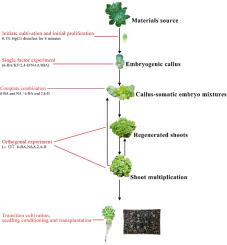Establishment of a high-efficiency embryogenic callus-somatic embryogenesis regeneration system in the succulent plant Sinocrassula indica var. viridiflora
IF 4.2
2区 农林科学
Q1 HORTICULTURE
引用次数: 0
Abstract
The endangered succulent Sinocrassula indica var. viridiflora K. T. Fu faces severe threats from habitat fragmentation and overexploitation. To address its conservation and commercial propagation challenges, an in vitro regeneration system was developed using mature leaves as explants. Sterilized leaves were cultured on MS medium supplemented with optimized plant growth regulator (PGR) combinations screened through single-factor, full factorial, and L9(34) orthogonal experimental designs. Synergistic effects of 6-BA and 2,4-D significantly enhanced embryogenic callus induction, with 1.5 mg/L 6-BA + 1.0 mg/L 2,4-D yielding compact, bright-green callus (proliferation coefficient: 7.50). Orthogonal optimization further identified 1.5 mg/L 6-BA + 0.5 mg/L NAA + 1.0 mg/L 2,4-D as the optimal proliferation medium (proliferation coefficient: 11.65). White frost-like structures dynamically associated with somatic embryo differentiation were observed during callus proliferation. Plantlet regeneration was markedly improved by separating clustered shoots, increasing the regeneration coefficient from 3.1 to 12.5. Regenerated plants exhibited stable rosette morphology with red-tipped leaves. Recycling regenerated leaves and embryogenic callus achieved a total proliferation coefficient exceeding 70.0. Acclimatized plantlets showed 100 % survival and retained ornamental traits. Histological analysis confirmed indirect somatic embryogenesis as the regeneration pathway, emphasizing the critical role of PGR balance and proliferation-differentiation regulation. This system provides a scalable solution for germplasm conservation and commercial production of S. indica var. viridiflora, while offering insights into morphogenetic control in succulent micropropagation.

多肉植物愈伤组织-体细胞胚发生高效再生体系的建立
濒危多肉植物Sinocrassula indica var. viridiflora K. T. Fu面临生境破碎化和过度开发的严重威胁。为了解决其保护和商业繁殖方面的挑战,以成熟叶片为外植体建立了离体再生体系。通过单因素、全因子和L9(34)正交试验设计,将灭菌后的叶片培养在添加优化植物生长调节剂(PGR)组合的MS培养基上。6-BA和2,4- d的协同作用显著促进了胚性愈伤组织的诱导,1.5 mg/L 6-BA + 1.0 mg/L 2,4- d可产生致密、亮绿色的愈伤组织(增殖系数为7.50)。正交优化进一步确定1.5 mg/L 6-BA + 0.5 mg/L NAA + 1.0 mg/L 2,4- d为最佳增殖培养基(增殖系数为11.65)。在愈伤组织增殖过程中观察到与体胚分化动态相关的白色霜样结构。分蘖后植株再生明显提高,再生系数由3.1提高到12.5。再生植株呈现稳定的莲座形态,叶尖呈红色。再生叶片和胚性愈伤组织的再生增殖系数均超过70.0。驯化后的植株成活率为100%,并保留了观赏性状。组织学分析证实了间接体细胞胚胎发生是再生途径,强调了PGR平衡和增殖分化调控的关键作用。该系统提供了一种可扩展的种质资源保护和商业生产解决方案,同时为多肉微繁的形态发生控制提供了见解。
本文章由计算机程序翻译,如有差异,请以英文原文为准。
求助全文
约1分钟内获得全文
求助全文
来源期刊

Scientia Horticulturae
农林科学-园艺
CiteScore
8.60
自引率
4.70%
发文量
796
审稿时长
47 days
期刊介绍:
Scientia Horticulturae is an international journal publishing research related to horticultural crops. Articles in the journal deal with open or protected production of vegetables, fruits, edible fungi and ornamentals under temperate, subtropical and tropical conditions. Papers in related areas (biochemistry, micropropagation, soil science, plant breeding, plant physiology, phytopathology, etc.) are considered, if they contain information of direct significance to horticulture. Papers on the technical aspects of horticulture (engineering, crop processing, storage, transport etc.) are accepted for publication only if they relate directly to the living product. In the case of plantation crops, those yielding a product that may be used fresh (e.g. tropical vegetables, citrus, bananas, and other fruits) will be considered, while those papers describing the processing of the product (e.g. rubber, tobacco, and quinine) will not. The scope of the journal includes all horticultural crops but does not include speciality crops such as, medicinal crops or forestry crops, such as bamboo. Basic molecular studies without any direct application in horticulture will not be considered for this journal.
 求助内容:
求助内容: 应助结果提醒方式:
应助结果提醒方式:


